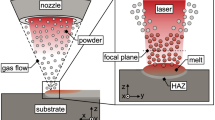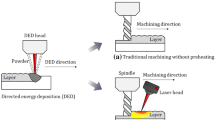Abstract
An additive/subtractive hybrid manufacturing (ASHM) combines the advantages of both additive and subtractive processes for fabricating complex parts of a better quality. While in an additive manufacturing process, temperature buildup is fast because of heat accumulation from a laser or electron beam, which exerts a great influence on the successive subtractive process. This study firstly measures the temperature variation of a Ti-6Al-4V workpiece in the direct material deposition (DMD) process, and then designs a heating device for a milling experiment at elevated temperatures. The effect of temperature buildup on milling forces is investigated through the experiment and a 2D thermal-mechanical coupling model. For work hardening effect and rapid tool wear, the milling forces are hardly decreased when the preheating temperature is lower than 300 °C. At a preheating temperature of 300 °C or higher, a significant reduction in milling forces is recorded, which may be attributed to the thermal softening effect on the workpiece material. The decreasing trend is more obvious at a larger feed-per-tooth. The thermal softening effect is reflected in the deformation layer in the subsurface of the machined workpiece. The study provides a guide to the determination of ASHM process parameters for Ti-6Al-4V.












Similar content being viewed by others
References
Nazir A, Abate KM, Kumar A, Jeng J-Y (2019) A state-of-the-art review on types, design, optimization, and additive manufacturing of cellular structures. Int J Adv Manuf Technol 104:1–22
Su X, Yang Y, Xiao D, Luo Z (2013) An investigation into direct fabrication of fine-structured components by selective laser melting. Int J Adv Manuf Technol 64(9–12):1231–1238
Kumar S, Sharma V, Choudhary AKS, Chattopadhyaya S, Hloch S (2013) Determination of layer thickness in direct metal deposition using dimensional analysis. Int J Adv Manuf Technol 67(9–12):2681–2687
Soboyejo WO, Srivatsan TS (2006) Advanced structural materials: properties, design optimization, and applications. Scitech Book News, vol 2. CRC press, Boca Raton
Malekipour E, El-Mounayri H (2018) Common defects and contributing parameters in powder bed fusion AM process and their classification for online monitoring and control: a review. Int J Adv Manuf Technol 95(1–4):527–550
Zhang B, Li Y, Bai Q (2017) Defect formation mechanisms in selective laser melting: a review. Chin J Mech Eng 30(3):515–527
Flynn JM, Shokrani A, Newman ST, Dhokia V (2016) Hybrid additive and subtractive machine tools–research and industrial developments. Int J Mach Tool Manu 101:79–101
Du W, Bai Q, Wang Y, Zhang B (2018) Eddy current detection of subsurface defects for additive/subtractive hybrid manufacturing. Int J Adv Manuf Technol 95(9–12):3185–3195
Liu J, Wang X, Wang Y (2017) A complete study on satellite thruster structure (STS) manufactured by a hybrid manufacturing (HM) process with integration of additive and subtractive manufacture. Int J Adv Manuf Technol 92(9–12):4367–4377
Xiong X, Zhang H, Wang G (2009) Metal direct prototyping by using hybrid plasma deposition and milling. J Mater Process Technol 209(1):124–130
Ye ZP, Zhang ZJ, Jin X, Xiao MZ, Su JZ (2017) Study of hybrid additive manufacturing based on pulse laser wire depositing and milling. Int J Adv Manuf Technol 88(5–8):1–12
Du W, Bai Q, Zhang B (2016) A novel method for additive/subtractive hybrid manufacturing of metallic parts ☆. Procedia Manuf 5:1018–1030
Swarnakar AK, Biest OVD, Baufeld B (2011) Thermal expansion and lattice parameters of shaped metal deposited Ti–6Al–4V. J Alloys Compd 509(6):2723–2728
Ginta TL, Amin AKMN (2013) Thermally-assisted end milling of titanium alloy Ti-6Al-4V using induction heating. Int J Mach Mach Mater 14(2):194–212
Dandekar CR, Shin YC, Barnes J (2010) Machinability improvement of titanium alloy (Ti–6Al–4V) via LAM and hybrid machining. Int J Mach Tool Manu 50(2):174–182
Sun S, Brandt M, Dargusch MS (2010) Thermally enhanced machining of hard-to-machine materials—a review. Int J Mach Tool Manu 50(8):663–680
Sun S, Brandt M, Barnes JE, Dargusch MS (2011) Experimental investigation of cutting forces and tool wear during laser-assisted milling of Ti-6Al-4V alloy. P I Mech Eng B-J Eng 225(9):1512–1527
Rashidab RAR, Sun S, Wang G, Dargusch MS (2012) An investigation of cutting forces and cutting temperatures during laser-assisted machining of the Ti–6Cr–5Mo–5V–4Al beta titanium alloy. Int J Mach Tool Manu 63:58–69
Hedberg GK, Shin YC, Xu L (2015) Laser-assisted milling of Ti-6Al-4V with the consideration of surface integrity. Int J Adv Manuf Technol 79(9–12):1645–1658
Yang D, Liu Z, Ren X, Zhuang P (2016) Hybrid modeling with finite element and statistical methods for residual stress prediction in peripheral milling of titanium alloy Ti-6Al-4V. Int J Mech Sci 108:29–38
Dinda GP, Song L, Mazumder J (2008) Fabrication of Ti-6Al-4V scaffolds by direct metal deposition. Metall Mater Trans A 39(12):2914–2922
Polishetty A, Shunmugavel M, Goldberg M, Littlefair G (2016) Singh RK (2016) cutting force and surface finish analysis of machining additive manufactured titanium alloy Ti-6Al-4V. Procedia Manufacturing 7:284–289
Milton S, Morandeau A, Chalon F, Leroy R (2016) Influence of finish machining on the surface integrity of Ti6Al4V produced by selective laser melting. Procedia CIRP 45:127–130
Bordin A, Bruschi S, Ghiotti A, Bucciotti F, Facchini L (2014) Comparison between wrought and EBM Ti6Al4V machinability characteristics. Key Eng Mater 611-612:1186–1193
Chen G, Ren C, Yang X, Jin X, Guo T (2011) Finite element simulation of high-speed machining of titanium alloy (Ti–6Al–4V) based on ductile failure model. Int J Adv Manuf Technol 56(9–12):1027–1038
Fahad M (2012) A heat partition investigation of multilayer coated carbide tools for high speed machining throughexperimental studies and finite element modelling. The University of Manchester (United Kingdom), Manchester
Thepsonthi T, Özel T (2013) Experimental and finite element simulation based investigations on micro-milling Ti-6Al-4V titanium alloy: effects of cBN coating on tool wear. J Mater Process Technol 213(4):532–542
Ding H, Shen N, Shin YC (2012) Thermal and mechanical modeling analysis of laser-assisted micro-milling of difficult-to-machine alloys. J Mater Process Technol 212(3):601–613
Waldorf DJ (1996) Shearing, ploughing, and wear in orthogonal machining. University of Illinois, Urbana-Champaign
Hou Y, Zhang D, Wu B, Luo M (2014) Milling force modeling of worn tool and tool flank wear recognition in end milling. IEEE-ASME T Mech 20(3):1024–1035
Ducobu F, Arrazola PJ, Rivière-Lorphèvre E, Filippi E (2015) Finite element prediction of the tool wear influence in Ti6Al4V machining. Procedia CIRP 31:124–129
Zamani H, Hermani J-P, Sonderegger B, Sommitsch C (2013) 3D simulation and process optimization of laser assisted milling of Ti6Al4 V. Procedia CIRP 8:75–80
Deng WJ, Xia W, Tang Y (2009) Finite element simulation for burr formation near the exit of orthogonal cutting. Int J Adv Manuf Technol 43(9–10):1035
Wu YC (2014) FEM simulation of milling tool wear for titaninum alloys TC4. Shangdong University, Jinan
Seo S, Min O, Yang H (2005) Constitutive equation for Ti–6Al–4V at high temperatures measured using the SHPB technique. Int J Impact Eng 31(6):735–754
Parida AK, Maity K (2019) Hot machining of Ti–6Al–4V: FE analysis and experimental validation. Sādhanā 44(6):142
Bermingham M, Sim W, Kent D, Gardiner S, Dargusch M (2015) Tool life and wear mechanisms in laser assisted milling Ti–6Al–4V. Wear 322:151–163
Zhou JM, Bushlya V, Peng RL, Johansson S, Avdovic P, Stahl JE (2011) Effects of tool wear on subsurface deformation of nickel-based superalloy. Procedia Engineering 19(1):407–413
Liu CR, Barash MM (1976) The mechanical state of the sublayer of a surface generated by chip-removal process—part 2: cutting with a tool with flank wear. J Eng Ind 98(4):1202
Altintas Y, Ber AA (2001) Manufacturing automation: metal cutting mechanics, machine tool vibrations, and CNC design. Appl Mech Rev 54(5):B84
Funding
The financial supports from the International cooperative research project of Shenzhen Science and Technology Innovation Commission (GJHZ20180411143506667) are gratefully acknowledged.
Author information
Authors and Affiliations
Corresponding author
Additional information
Publisher’s note
Springer Nature remains neutral with regard to jurisdictional claims in published maps and institutional affiliations.
Rights and permissions
About this article
Cite this article
Li, S., Zhang, B. & Bai, Q. Effect of temperature buildup on milling forces in additive/subtractive hybrid manufacturing of Ti-6Al-4V. Int J Adv Manuf Technol 107, 4191–4200 (2020). https://doi.org/10.1007/s00170-020-05309-7
Received:
Accepted:
Published:
Issue Date:
DOI: https://doi.org/10.1007/s00170-020-05309-7




